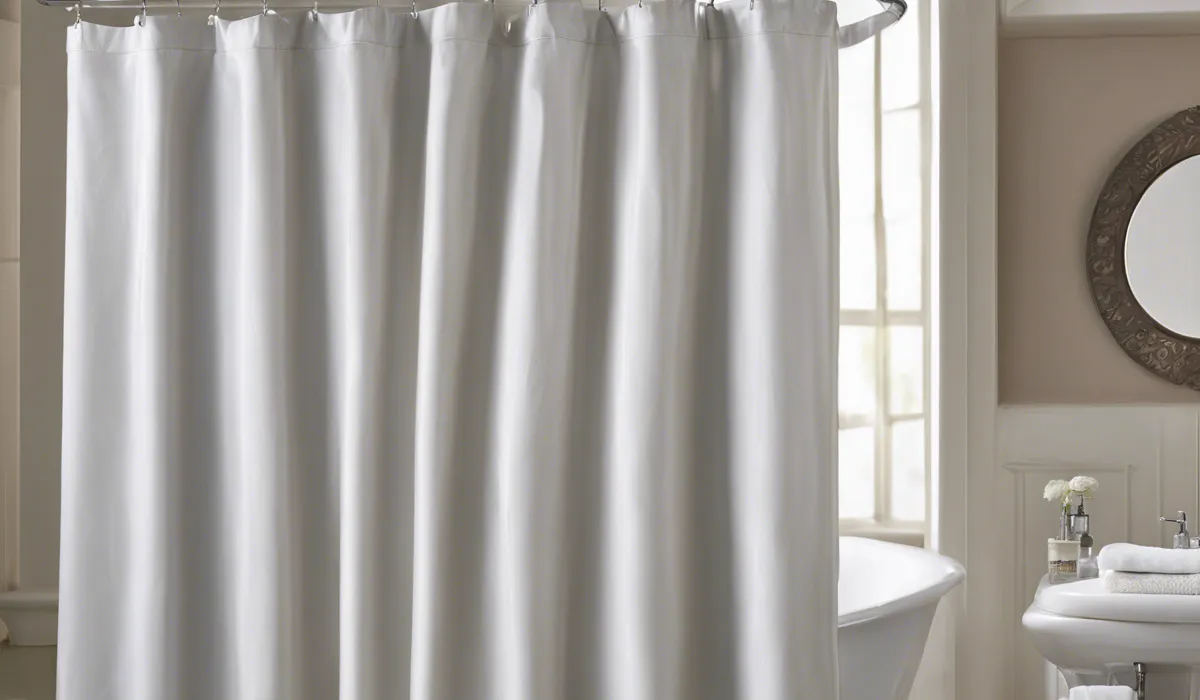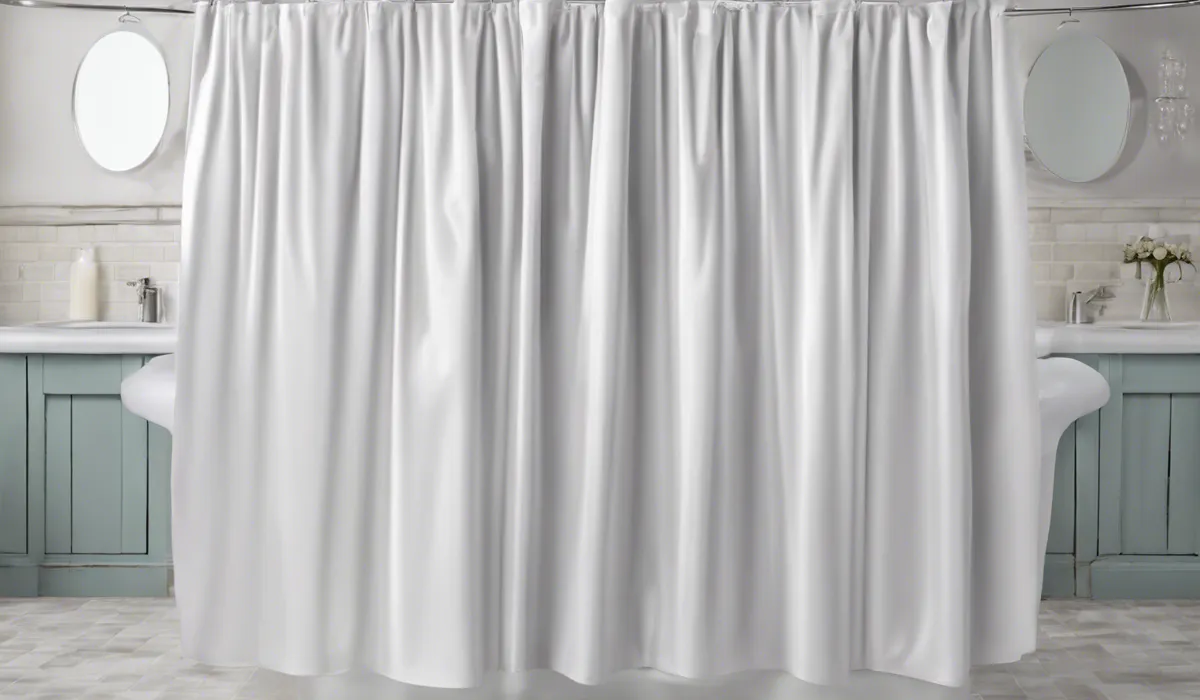To wash a fabric shower curtain with mildew, remove it from the rings and place it in your washing machine with 1 cup of baking soda. Add white vinegar during the rinse cycle. Use a gentle setting with warm water. Hang to dry or use a low heat dryer setting.
Preparing the Shower Curtain for Washing

Removal and Initial Treatment
Starting with the right approach to preparation is critical when it comes to washing your fabric shower curtain.
Begin by gently removing the curtain from the hooks or rings, being careful not to tear the fabric.
Once removed, give it a good shake to dislodge any loose mildew, debris, or soap scum that may be clinging to the surface.
This action helps to ensure that you’re not washing in extra dirt that could be easily removed beforehand.
Pre-Treating Stains
Inspect the curtain for any visible mildew stains. Apply a mildew stain remover following the product’s instructions or use a homemade solution, such as a mixture of water and a small amount of bleach or hydrogen peroxide.
Be sure to test any homemade solutions on a small area first to prevent discoloration. Allow the pre-treatment to sit for the recommended amount of time to penetrate and break down the mildew.
Preparing for the Wash
After pre-treatment, either lay the curtain flat or hang it in a well-ventilated area. Doing so will prevent new mildew from forming and will make the curtain easier to handle when it’s time to wash.
This step is important to ensure the fabric is not bundled up, which could trap moisture and lead to further mildew growth.
Choosing the Right Washing Method

Machine Washing Essentials
If you opt for machine washing, first select the gentle cycle setting on your washing machine, and adjust the water temperature to warm—this combination is gentle enough for most fabric shower curtains and effective against mildew.
Add a suitable amount of mild detergent, following the manufacturer’s recommendation, to avoid soap residue, which can also contribute to mildew growth.
Including Additional Items
To prevent the curtain from wrinkling or getting damaged during the wash, include a few towels or similar items in the load.
These items help to balance out the washing machine and ensure that the curtain gets cleaned evenly. This method also helps to buffer any rough tumbling that might occur during the cycle.
Using Natural Additives
Vinegar and baking soda are natural allies in the fight against mildew. Add 1 cup of baking soda to the wash cycle and pour white vinegar into the rinse cycle dispenser.
This combination not only helps to kill mildew but also deodorizes and brightens the fabric.
Hand Washing Procedure
If a washing machine is not an option, hand washing is an effective alternative. Fill a bathtub or large basin with warm water and add a small amount of mild detergent. For additional mildew removal power, mix in vinegar or baking soda.
Use this solution to gently scrub the curtain with a soft brush or sponge, paying special attention to any stained areas.
Thorough Rinse
After scrubbing, rinse the curtain thoroughly with clean water to ensure that all the soap, vinegar, or baking soda is washed away.
Any remaining cleaning agents can attract dirt or contribute to mildew formation, so it’s essential to rinse well.
Drying and Rehanging the Shower Curtain

Removing Excess Water
Once the washing is complete, remove the curtain carefully from the washer or bathtub, shaking off any excess water.
Check again for any mildew spots that may have been missed. If any stains remain, you may need to repeat the pre-treatment and washing steps.
Drying Options
Choose the best drying method for your situation. If the weather permits, hanging the curtain outside in the sun can provide additional disinfecting benefits due to the sun’s UV rays.
If you must dry it inside, using a dryer on a low heat or air-only setting is acceptable if the curtain’s care instructions permit. Otherwise, rehang the curtain in the shower to air dry, ensuring it’s fully spread out to prevent new mildew spots.
Reattaching the Curtain
After the curtain is dry, it’s time to reattach it to the hooks or rings. Make sure it’s evenly spread to avoid bunching, which can lead to mildew.
Ensure the bathroom has good airflow to aid in drying and to prevent mildew from forming in the future.
Preventing Future Mildew Growth
To ensure that your shower curtain remains free of mildew, keep the bathroom well-ventilated, especially after showers when humidity is high.
Consider using a daily shower spray to prevent mildew and soap scum buildup. Regular cleaning and maintenance will keep your curtain looking fresh and extend its life.
FAQs About Washing Fabric Shower Curtains With Mildew
What is the first step to wash a fabric shower curtain with mildew?
The first step is to remove the fabric shower curtain from the rings and place it in the washing machine.
What should I add to the washing machine to clean a mildewed shower curtain?
Add 1 cup of baking soda to the washing machine when washing the curtain.
When do I add white vinegar during the washing process?
Add white vinegar to the washing machine during the rinse cycle to help remove mildew.
What setting should I use to wash the fabric shower curtain?
Use a gentle setting with warm water to wash the curtain.
What is the best way to dry a fabric shower curtain after washing it?
Hang the curtain to dry or use a low heat dryer setting if necessary.
Final Thoughts
To effectively remove mildew from a fabric shower curtain, it should be machine washed with 1 cup of baking soda and warm water on a gentle setting.
Incorporate white vinegar during the rinse cycle for enhanced cleaning. After washing, either hang the curtain to dry or use a low heat setting in the dryer.
